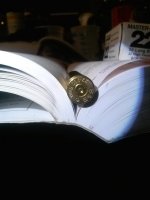ageingstudent
Member
I attached a few pics of some 22-250 factory once fired brass from my Savage. Not picking on that brand of ammo in the picture because I notice that most factory ammo I shoot looks similar, with the exception of UMC for some reason. My handloads usually don't flatten and crater like this until I get to within a few tenths of max. It's so consistent I have come to feel it is normal, but I thought I might put it up here and see what fellow 22-250 handloaders think. I get a few split necks from factory fresh ammo too, probably 1 in 40 rounds. Is the factory stuff just loaded up near max? I definently get more felt recoil and the rifle jumps more with factory loads. Appreciate any thoughts, thanks.


